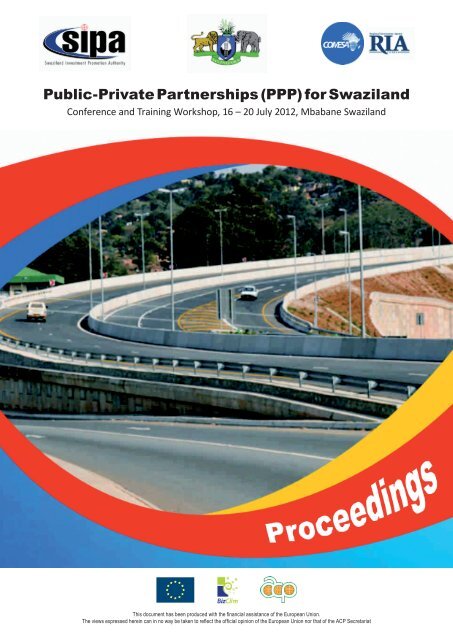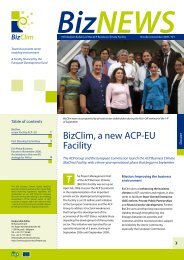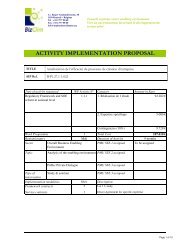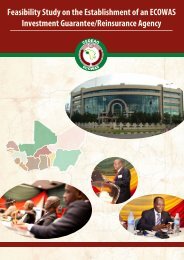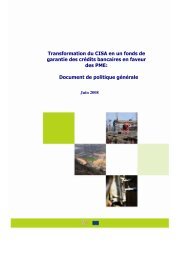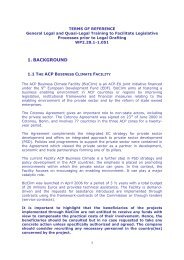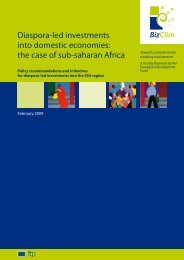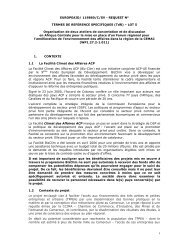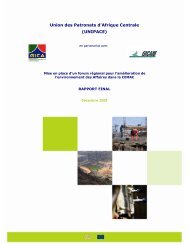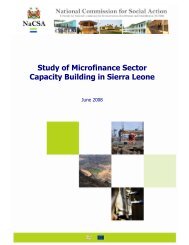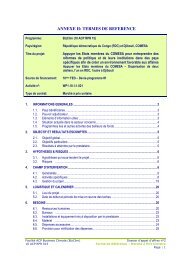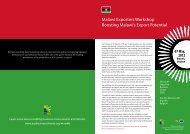(PPP) for Swaziland - ACP Business Climate
(PPP) for Swaziland - ACP Business Climate
(PPP) for Swaziland - ACP Business Climate
You also want an ePaper? Increase the reach of your titles
YUMPU automatically turns print PDFs into web optimized ePapers that Google loves.
Public-Private Partnerships (<strong>PPP</strong>) <strong>for</strong> <strong>Swaziland</strong><br />
Conference and Training Workshop, 16 – 20 July 2012, Mbabane <strong>Swaziland</strong><br />
This document has been produced with the financial assistance of the European Union.<br />
The views expressed herein can in no way be taken to reflect the official opinion of the European Union nor that of the <strong>ACP</strong> Secretariat
About the organisers<br />
2<br />
The <strong>Swaziland</strong> Investment Promotion Authority (SIPA) was created through an Act of Parliament, the <strong>Swaziland</strong><br />
Investment Promotion Act 1998 and was <strong>for</strong>mally launched in April of the same year. SIPA is a Category<br />
A Public Enterprise and is wholly funded by the Government of <strong>Swaziland</strong>, with initial assistance from the<br />
European Union.<br />
<strong>Swaziland</strong>’s Ministry of Finance is in charge of Government procurement and hence is the custodian of the<br />
<strong>PPP</strong> Policy. The previous work done in assisting <strong>Swaziland</strong>, which culminated in a draft <strong>PPP</strong> Policy and draft<br />
guidelines are currently being worked on by the Ministry, with a view to submitting them to Cabinet, hence<br />
the workshop will help in<strong>for</strong>m the draft to Cabinet. The Ministry is also an active member of the SADC <strong>PPP</strong><br />
Network, the <strong>Swaziland</strong> chapter of which was launched during the workshop.<br />
The COMESA Regional Investment Agency (RIA), launched in June 2006, aims to make the COMESA region<br />
a viable, attractive destination <strong>for</strong> regional and international investors. In the long term, RIA’s vision is to<br />
present the COMESA region as a fully integrated, internationally, competitive regional economic community.<br />
The <strong>ACP</strong> <strong>Business</strong> <strong>Climate</strong> facility (BizClim) is a programme of the <strong>ACP</strong> Secretariat financed by the European<br />
Union under the 10th European Development Fund (EDF). It aims at fostering a business-enabling environment<br />
in <strong>ACP</strong> countries and regions by improving legislation, institutional frameworks and financial measures<br />
relating to the enabling environment of the private sector.<br />
BKP Development Research & Consulting GmbH is an economic research and consulting firm based in Munich<br />
(Germany) with associates in Ethiopia, Ghana and the Netherlands. Since establishment, BKP Development<br />
has completed more than 40 projects, research and lecturing assignments <strong>for</strong> governments, institutions and<br />
academia worldwide. BKP Development specialises in International trade and regional integration; Investment<br />
promotion (incl. investment climate assessments, competitiveness studies, etc.); and Private sector<br />
development (incl. competition policy, <strong>PPP</strong>, etc.).
Table of Contents<br />
Introduction..............................................................................................................................................................4<br />
3<br />
Day 1 // Conference on <strong>PPP</strong>......................................................................................................................................5<br />
Opening Statements..................................................................................................................................................5<br />
Introduction to <strong>PPP</strong>....................................................................................................................................................5<br />
Launch of SADC <strong>PPP</strong> Network....................................................................................................................................6<br />
<strong>Swaziland</strong>’s <strong>PPP</strong> Experience.......................................................................................................................................7<br />
The Context <strong>for</strong> <strong>PPP</strong> in <strong>Swaziland</strong>..............................................................................................................................8<br />
<strong>PPP</strong> in <strong>Swaziland</strong> – a Private Sector Perspective........................................................................................................9<br />
Day 2 – 5 // Training Programme on <strong>PPP</strong>...............................................................................................................10<br />
<strong>PPP</strong> Project Life Cycle...............................................................................................................................................11<br />
Selecting the Right Projects <strong>for</strong> <strong>Swaziland</strong>...............................................................................................................11<br />
Syndicate Group Work on <strong>PPP</strong> Constraints in <strong>Swaziland</strong>.........................................................................................12<br />
Risk Allocation .........................................................................................................................................................13<br />
Syndicate Group Work on Output Specification and Risk Calculation.....................................................................14<br />
Discussion on Payment Mechanisms / Contract Management ...............................................................................16<br />
Key Issues <strong>for</strong> <strong>Swaziland</strong> during the Procurement phase .......................................................................................16<br />
Contract Management beyond Financial Close.......................................................................................................18<br />
Review of the Training Workshop // Evaluation and Action Planning..............................................................19<br />
Evaluation of the Training Method..........................................................................................................................19<br />
Summary of <strong>PPP</strong> Critical Success Factors identified................................................................................................19<br />
<strong>PPP</strong> Projects Identified ............................................................................................................................................20<br />
Learning Effect and the Way Forward.....................................................................................................................20<br />
Closure of the training............................................................................................................................................21
The conference was attended by more than 80 participants from various parts of the private and the public sector, who all wish to contribute to the<br />
success of future <strong>PPP</strong> projects in <strong>Swaziland</strong> and the region.<br />
Introduction<br />
4<br />
The Government of <strong>Swaziland</strong>, through the Ministry<br />
of Finance and the <strong>Swaziland</strong> Investment Promotion<br />
Authority (SIPA) and with the support of the <strong>ACP</strong> <strong>Business</strong><br />
<strong>Climate</strong> Facility (BizClim) organised a one-week<br />
event on Public-Private Partnerships (<strong>PPP</strong>), consisting<br />
of a one-day conference and a four-day intensive<br />
training programme, from July 16 to 20, 2012.<br />
The conference aimed at raising awareness of a wide<br />
range of stakeholders about the current situation of<br />
<strong>PPP</strong>s and about opportunities and potential future<br />
developments in <strong>Swaziland</strong>. It also served as a plat<strong>for</strong>m<br />
<strong>for</strong> the launch of the SADC <strong>PPP</strong> Network in <strong>Swaziland</strong>.<br />
The purpose of the training programme was to<br />
strengthen the capacity of <strong>Swaziland</strong> Government and<br />
SIPA, as well as that of relevant ministries and government<br />
agencies of other African countries, <strong>for</strong> the <strong>for</strong>mulation,<br />
development and management of <strong>PPP</strong> projects.<br />
The workshop should also help <strong>Swaziland</strong> in developing<br />
its own <strong>PPP</strong> model and procedures by providing practical<br />
tools and taking best practices from other countries<br />
as a model.<br />
The event was attended by more than 80 participants,<br />
both representatives of relevant ministries / institutions<br />
and companies in <strong>Swaziland</strong> and experts from the<br />
COMESA region, who provided regional experiences.<br />
For more in<strong>for</strong>mation, including workshop<br />
presentations and reading materials, please visit<br />
the workshop website:<br />
http://www.swaziland-ppp.org
Zizwe Vilane Amadou Traoré David Wright<br />
Day 1 // Conference on <strong>PPP</strong><br />
Opening Statements<br />
In his opening speech Zizwe Vilane, the acting CEO of<br />
the <strong>Swaziland</strong> Investment Promotion Agency, stated<br />
that it was the right moment to launch <strong>PPP</strong> projects<br />
in <strong>Swaziland</strong>. On the one hand, the government had<br />
limited resources to finance infrastructure. At the same<br />
time, various recent developments – such as the Piggs<br />
Peak Hotel, the Tolling Project, the construction of Fuel<br />
Reserves, Sikhuphe Airport, the IT and Bio Technology<br />
Parks – needed private sector involvement. He was<br />
convinced that the workshop would help to prepare<br />
<strong>Swaziland</strong> <strong>for</strong> the realization of <strong>PPP</strong>s.<br />
Amadou Traoré, Chargé d’Affaires of the EU Delegation<br />
in <strong>Swaziland</strong>, highlighted that the European Union was<br />
the largest donor in the world but that official development<br />
aid could not meet all the development challenges,<br />
no matter how important they were. A vibrant<br />
private sector capable of being the engine of economic<br />
growth is there<strong>for</strong>e necessary.<br />
As the private sector can only strive if it has the right<br />
environment the EU promotes policies at national and<br />
regional levels to strengthen enterprise competitiveness,<br />
supports good governance and the implementation<br />
of fiscal and custom re<strong>for</strong>ms, trade facilitation<br />
measures, and encourages <strong>PPP</strong>s. The EU seeks to tap<br />
the private sector’s vast resources, expertise and<br />
know-how to develop infrastructure networks in Africa<br />
by promoting <strong>PPP</strong>s based on the use of subsidies to<br />
leverage private financing.<br />
Finally, the EU representatives issued a word of caution.<br />
While <strong>PPP</strong>s were a good tool <strong>for</strong> the public sector to<br />
finance measures that were otherwise not feasible,<br />
and while the training programme would certainly help<br />
how to plan and conduct successful <strong>PPP</strong>s in <strong>Swaziland</strong>,<br />
one should not <strong>for</strong>get that <strong>PPP</strong>s are by no means a<br />
panacea that alone can overcome a country’s challenges.<br />
Introduction to <strong>PPP</strong><br />
<strong>PPP</strong> expert David Wright gave a general introduction<br />
on the <strong>PPP</strong> concept.<br />
As the term <strong>PPP</strong> suggests, a successful partnership between<br />
the private and public sector is the crucial part of<br />
<strong>PPP</strong> project. It is a contractual arrangement to deliver<br />
a service (not necessarily an asset).<br />
People often consider that the financing is the magic<br />
part of <strong>PPP</strong> projects. High ranked public officials believe<br />
that <strong>PPP</strong>s can deliver government services at no cost.<br />
However, it is important to understand that such <strong>PPP</strong><br />
projects are rarely possible and only under very specific<br />
circumstances. Usually, the government is financially<br />
involved.<br />
Key aspects that have to be considered while planning<br />
<strong>PPP</strong>s are ‘af<strong>for</strong>dability’ and ‘capacity to accept risks’.<br />
The country needs to be able to repay the investment<br />
or else it will not attract the private sector.<br />
Also, the roles of the public and private sectors in a <strong>PPP</strong><br />
need to be clarified: The public sector has to define<br />
what it wants the private sector to do. The private<br />
sector then defines how it should be realized.<br />
There are several categories of countries if classified<br />
according to their use of <strong>PPP</strong>. Many countries still do<br />
not have such projects at all. Some have extensive<br />
experience. Yet others have a few <strong>PPP</strong>s which are<br />
plagued with problems, such as lack of transparency<br />
5
Sizakele Dlamini<br />
Johan Kruger<br />
6 in the procurement process, corruption and nepotism.<br />
On such a basis a country can never attract much private<br />
investment! In designing its own <strong>PPP</strong> policy and<br />
processes, <strong>Swaziland</strong> needs to be careful not to repeat<br />
the mistakes of some other countries.<br />
Launch of SADC <strong>PPP</strong> Network<br />
Sizakele Dlamini, Ministry of Finance Director Corporate<br />
Services and Supply Chain, presented the<br />
current status and the prospects of the recently launched<br />
SADC <strong>PPP</strong> Network.<br />
The SADC governments have realised that there is an<br />
infrastructure financing gap across all SADC countries<br />
and that <strong>PPP</strong>s could help mobilising financial resources<br />
<strong>for</strong> infrastructure investment. In response, they have<br />
launched a <strong>PPP</strong> network in order to strengthen the<br />
capacity of the public sector to engage in <strong>PPP</strong> projects<br />
through different trainings, working groups and the<br />
sharing of in<strong>for</strong>mation and experiences (on an electronic<br />
plat<strong>for</strong>m).<br />
For more in<strong>for</strong>mation on the SADC<br />
<strong>PPP</strong> network, please visit the following website:<br />
www.sadcpppnetwork.org<br />
The network is open to all <strong>PPP</strong> practitioners from the<br />
SADC region. It is composed of a Steering Committee<br />
comprising a representative (and alternate) from each<br />
SADC Member State <strong>for</strong> programmatic and technical<br />
guidance, a Secretariat placed within the SADC<br />
Development Finance Resource Centre (DFRC), and an<br />
Advisory Committee comprising financial and technical<br />
partners to advice on funding and programmes.
<strong>Swaziland</strong>’s <strong>PPP</strong> Experience<br />
<strong>PPP</strong> expert Johan Kruger addressed the elaboration<br />
process and the content of <strong>Swaziland</strong>’s draft <strong>PPP</strong> policy.<br />
In 2008 the Government of the Kingdom of <strong>Swaziland</strong><br />
applied to BizClim <strong>for</strong> assistance to <strong>for</strong>mulate a <strong>PPP</strong><br />
policy. The objective was to develop a comprehensive,<br />
clearly articulated and pro-poor <strong>PPP</strong> policy accompanied<br />
by a framework in the <strong>for</strong>m of an operational<br />
manual to assist in structuring win-win <strong>PPP</strong> deals.<br />
The following steps were fixed <strong>for</strong> the development of<br />
the policy:<br />
1. Interviews of stakeholders (ministries, labour and<br />
private sector);<br />
2. Preparation of a Situation Report, followed by a<br />
consultation of stakeholders;<br />
3. Preparation of a draft Policy Framework, again<br />
followed by a consultation of stakeholders;<br />
4. Approval of the final <strong>PPP</strong> Policy by Government;<br />
5. reparation of an Operational Manual.<br />
The responsibilities were attributed to different ministries.<br />
A Public Enterprises Unit and Tender Board<br />
has been installed in the Ministry of Finance, while<br />
the Ministry of Economic Planning and Development<br />
is responsible <strong>for</strong> the coordination and management<br />
of Government’s capital programme. Line Ministries<br />
(Public Works, Health etc.) are in charge of identifying,<br />
designing and implementing the projects.<br />
Initially, the concept of <strong>PPP</strong> did not meet with uni<strong>for</strong>m<br />
approval in <strong>Swaziland</strong>. On the political level there were<br />
very high expectations, couple however with concerns<br />
that officials’ expertise to handle <strong>PPP</strong> projects was not<br />
sufficient. At the same time, some private sector stakeholders<br />
were concerned about the possible dominance<br />
of <strong>for</strong>eign companies. Labour feared negative consequences<br />
<strong>for</strong> workers, and parts of the financial sector<br />
did not see enough opportunities <strong>for</strong> <strong>PPP</strong> in <strong>Swaziland</strong>.<br />
Despite these concerns, there have been several small<br />
successful <strong>PPP</strong> projects. The most common problems<br />
were the lack of common understanding and coordination,<br />
insufficient planning capacity and structuring<br />
support, lack of capital and business training <strong>for</strong><br />
outsourced employees, limited possibilities <strong>for</strong> local<br />
participation, lack of competition (natural monopoly)<br />
and of political commitment to set cost recovery tariffs.<br />
To avoid these difficulties in future, regulations should<br />
be <strong>for</strong>mulated. Line departments need to operate<br />
within the policy guidelines, followed by a due process<br />
that will include the project in the public entity’s budget<br />
according to normal planning and budgetary guidelines<br />
and the completion of a proper feasibility study.<br />
It was also recommended that <strong>Swaziland</strong> create a <strong>PPP</strong><br />
technical assistance unit and a secretariat, regulate<br />
the approval process and delegations allow the use of<br />
transaction advisors, provide appropriate training,<br />
mandate the auditor general to monitor projects on<br />
a random to ensure the application of the value <strong>for</strong><br />
money principle, create opportunities <strong>for</strong> the local<br />
private sector and stipulate requirements <strong>for</strong> the<br />
involvement of local firms and private individuals.<br />
It is very important that the first pilot projects are successful<br />
as they lay the basis <strong>for</strong> further projects. They<br />
should have the strong support from all stakeholders<br />
and viable income streams and must not result in<br />
job losses or the necessity <strong>for</strong> substantial changes in<br />
conditions of service.<br />
<strong>PPP</strong>s require hard and consistent ef<strong>for</strong>t and cooperation<br />
between ministries but there are tremendous opportunities<br />
in the Kingdom.<br />
7
Kimon Paxinos, Workshop Facilitator seated on the right<br />
8 The Context <strong>for</strong> <strong>PPP</strong> in <strong>Swaziland</strong><br />
Workshop Facilitator kimon Paxinos in<strong>for</strong>med about<br />
the economic and political context of <strong>PPP</strong>s in <strong>Swaziland</strong>.<br />
He stated that <strong>Swaziland</strong> faces several challenges that<br />
have an impact on potential <strong>PPP</strong> projects. First, the<br />
high HIV incidence rate of 26 % and the feminisation of<br />
the disease lead to a breakdown of social service delivery<br />
and economic productivity. Second, only limited<br />
markets can af<strong>for</strong>d a tariff as 69 % of the population<br />
live below the poverty line. Third, economic per<strong>for</strong>mance<br />
and human development have stagnated since<br />
the 1990s. Although a middle class has developed,<br />
the poorest third of the population has become even<br />
poorer over the past ten years. Also, gender inequality<br />
reduces the probability of <strong>PPP</strong>s.<br />
There is a clear need <strong>for</strong> private sector investment to<br />
support growth, and although the current business<br />
environment has been evaluated as relatively weak<br />
(graph 1) the perspectives seem to be good. The<br />
Government has introduced public sector re<strong>for</strong>ms.<br />
<strong>Swaziland</strong> can use <strong>PPP</strong>s to diversify the economy. However,<br />
effective <strong>PPP</strong> implementation is critical to investment,<br />
job creation and economic diversification of<br />
<strong>Swaziland</strong>.<br />
Graph 1: <strong>Swaziland</strong>’s Doing business Indicators, 2012<br />
(<strong>Swaziland</strong>’s rank out of 183 economies)<br />
The close linkage of <strong>Swaziland</strong>’s economy to South Africa<br />
(60 % of exports / 80 % of imports), the monopolised<br />
telecommunication system and heavy regulation make<br />
<strong>Swaziland</strong>’s economy vulnerable. Also, the overvalued<br />
exchange rate hampers exports.<br />
The political system of <strong>Swaziland</strong> is a combination of<br />
a Westminster type constitution and traditional monarchy.<br />
The Constitution fixes the separation of powers<br />
between the King and the State but in practice, powers<br />
are not always clearly assigned. The same applies to<br />
the relations between the highly devolved tinkhundla<br />
and central government.<br />
Source: www.doingbusiness.org
Zodwa Mabuza<br />
<strong>PPP</strong> in <strong>Swaziland</strong> –<br />
a Private Sector Perspective<br />
Finally Zodwa Mabuza, the CEO of the Federation of<br />
<strong>Swaziland</strong> Employers and Chamber of Commerce, gave a<br />
private sector perspective on the issue of Public Private<br />
Partnerships in <strong>Swaziland</strong>.<br />
A <strong>PPP</strong> is a clear agreement of public infrastructure or<br />
public services delivery based on shared objectives but<br />
different goals. Both parties want enhanced delivery of<br />
infrastructure or services, but the public sector wants<br />
to leverage skills and resources of the private sector<br />
without shouldering all the risk while the private sector<br />
wants to contribute to enhanced service delivery via<br />
long term profitable contracts. A successful <strong>PPP</strong> needs<br />
a good working relationship and trust between the<br />
public and private sectors <strong>for</strong> the identification of<br />
mutually beneficial projects, specialised and independent<br />
professionals to evaluate projects and draw up<br />
contracts, a transparent and accountable procurement<br />
and tendering process and strong commercial courts<br />
<strong>for</strong> en<strong>for</strong>cement of contracts.<br />
In <strong>Swaziland</strong>, <strong>PPP</strong>s could close the infrastructure and<br />
service delivery gap. The private sector would become<br />
the driver <strong>for</strong> economic growth (instead of the Government<br />
that currently contributes 40 % to <strong>Swaziland</strong>’s<br />
GDP). Also, financial institutions would be required to<br />
invest more of their assets locally.<br />
Possible fields <strong>for</strong> <strong>PPP</strong>s are<br />
• Agriculture (e.g. irrigation systems <strong>for</strong> government<br />
owned farms);<br />
• Energy (e.g. electricity generation with independent<br />
power producers, renewable energy projects);<br />
• Health (e.g. construction of hospital laboratories,<br />
joint procurement of latest technologies / equipment);<br />
and<br />
• Construction (e.g. specialised factory shells).<br />
But several problems compromise the success of <strong>PPP</strong><br />
projects in <strong>Swaziland</strong>: The lack of transparency and<br />
accountability in procurement and tendering fosters<br />
corruption. The political and economic uncertainty<br />
makes planning <strong>for</strong> projects difficult and reduces their<br />
attractiveness. And finally, <strong>PPP</strong>s fail to be launched as<br />
there is limited trust between Government and the<br />
private sector.<br />
According to the private sector, the Ministry of Finance<br />
should hold thorough consultations on the <strong>PPP</strong> Policy<br />
Framework. A Procurement Bill needs to be passed<br />
into an Act so that it is binding to actors. Independent<br />
and well-capacitated commercial courts and an effective<br />
Anti-Corruption Commission should be established.<br />
Further capacity building, in addition to the current<br />
training programme, <strong>for</strong> both public and private sector<br />
personnel on <strong>PPP</strong>s is urgently needed.<br />
A few positive steps have already been taken: a draft<br />
<strong>PPP</strong> policy framework has been developed, a SADC <strong>PPP</strong><br />
network has been launched, re<strong>for</strong>ms to the procurement<br />
process have been initiated via the Public Procurement<br />
Bill of 2009, and an Investor Roadmap has been<br />
developed to introduce strong commercial courts and<br />
investor protection measures.<br />
The perspectives are also promising: The current fiscal<br />
position of Government and the plans <strong>for</strong> infrastructure<br />
development in the SADC region present an opportunity<br />
<strong>for</strong> <strong>PPP</strong>s. The Guidelines will serve as a base to <strong>for</strong>mulate<br />
an effective <strong>PPP</strong> policy, and several <strong>PPP</strong>s that<br />
have taken place without a framework indicate at<br />
least some level of trust between government and the<br />
private sector.<br />
9
Day 2 – 5 // Training Programme on <strong>PPP</strong><br />
10 The training programme took place during the remaining<br />
four days. The workshop methodology consisted<br />
of a mixture of lectures and, mostly, working groups.<br />
<strong>PPP</strong> concepts and the different steps of realising <strong>PPP</strong><br />
project were introduced and explained by the trainers,<br />
who also provided illustrations and case studies<br />
from various countries. Participants from other African<br />
countries presented success and failure cases from<br />
their own countries.<br />
After the presentations, all participants had the opportunity<br />
to ask questions and to discuss different examples.<br />
During working group sessions the participants got the<br />
possibility to apply their knowledge to the situation in<br />
<strong>Swaziland</strong>. They had to measure good practice against<br />
existing practice in <strong>Swaziland</strong>. They worked on specific<br />
topics to work out individual policy suggestions, recommendations,<br />
action and implementation plans. After<br />
each working session each group would present their<br />
result in the plenary and compare it with the others.<br />
The syndicate work took the <strong>for</strong>m of action research<br />
and lead to participants understanding and being able<br />
to continue their learning on-the-job through a process<br />
called action learning. Each time the participants also<br />
discussed the <strong>for</strong>m and the content of the presentation<br />
in order to improve their communication and presentations<br />
skills.<br />
The participants came mainly from the public sector<br />
but there were also representatives of private companies<br />
who could explain their interests, objectives and<br />
concerns to the public officials. The sharing of experiences<br />
and in<strong>for</strong>mation was very fruitful.<br />
“One realised that colleagues from Ethiopia and<br />
Zambia also faced similar challenges regarding the<br />
effective use of <strong>PPP</strong>s.”<br />
Lungile Dlamini, Municipal Council of Manzini<br />
Also, the regional exchange of experience was considered<br />
to be very helpful <strong>for</strong> both the Swazi and regional<br />
participants. By applying fresh perspectives to the analysis<br />
of the situation in <strong>Swaziland</strong>, interesting approaches<br />
were developed to solve current problems.<br />
***<br />
In the following, the content of the training workshop,<br />
the results of the question and answer sessions, debates<br />
and discussions and the syndicate group work are<br />
summarised.
The training programme was attended by approx. 50 participants from various parts of the private and the public sector.<br />
<strong>PPP</strong> Project Life Cycle<br />
The <strong>PPP</strong> project life cycle consists of four stages:<br />
1. Project identification: A project needs to be identified,<br />
selected and defined. A description of what the<br />
public wants to procure – the output specifications –<br />
is essential. Then, <strong>PPP</strong> options are assessed and an appropriate<br />
one chosen based on the following criteria:<br />
af<strong>for</strong>dability, risk allocation, accounting treatment,<br />
“bankability”, and value <strong>for</strong> money.<br />
2. Detailed preparation: A project and an advisory<br />
team are <strong>for</strong>med and a plan / timetable is worked<br />
out. Then, further studies, a detailed <strong>PPP</strong> design, a<br />
procurement method, bid evaluation criteria and<br />
draft <strong>PPP</strong> contract have to be prepared.<br />
3. Procurement: The bidding process includes a notice<br />
to advertise the project, a pre-qualification procedure<br />
to select a shortlist, interaction with bidders<br />
and selection of a preferred bidder. Afterward the<br />
parties sign the final <strong>PPP</strong> contract, financing agreements<br />
are completed and financial close is reached.<br />
4. Project Implementation: <strong>PPP</strong> management includes<br />
administration and management responsibilities,<br />
monitoring service outputs, changes to the <strong>PPP</strong> contract,<br />
dispute resolution, <strong>PPP</strong> contract termination. Ex<br />
post evaluation: institutional framework, analytical<br />
framework.<br />
Selecting the Right Projects <strong>for</strong><br />
<strong>Swaziland</strong><br />
Some key aspects have to be considered when selecting<br />
<strong>PPP</strong> projects <strong>for</strong> <strong>Swaziland</strong>:<br />
• Scale of the project: Projects need to be of sufficient<br />
scale to justify the use of the <strong>PPP</strong> approach and<br />
to attract market interest. Current guidance is that<br />
projects involving private finance need to be of a<br />
scale of at least USD 20 million to be viable. But the<br />
government may bundle a number of smaller projects<br />
together in order to reach an appropriate scale.<br />
• Significant service or operational requirements: Projects<br />
that combine design, build, operate, maintain<br />
and finance to reduce interface risk by having one<br />
party responsible <strong>for</strong> all aspects of the project make<br />
good <strong>PPP</strong>s. <strong>PPP</strong> projects with significant ‘upfront’<br />
construction costs and minimal whole-life operating<br />
and maintenance costs are unlikely to deliver added<br />
value.<br />
• User charges/third party income: If acceptable, the<br />
charges to the public <strong>for</strong> use of the asset or services<br />
provided under the <strong>PPP</strong> arrangement can <strong>for</strong>m part<br />
of the income stream. If realistic, an extra income<br />
can be generated outside of the core income source.<br />
• Existence of a competitive market: Market consultation<br />
may be needed to identify or clarify suitable options<br />
or solutions, determine the bankability of and<br />
the market interest in the proposed project. Risks<br />
that will be transferred and the private sector’s willingness<br />
to accept them should be evaluated.<br />
11
12 • Stability of future demand: <strong>PPP</strong> contracts are longterm,<br />
typically 25 to 30 years. The private sector<br />
must develop an integrated long-term solution but<br />
the public sector must also consider and prepare<br />
<strong>for</strong> changes to the <strong>PPP</strong> structure if circumstances<br />
change. <strong>PPP</strong>s are not a suitable solution if the demand<br />
is likely to be unstable.<br />
• Expression of demand in output terms (= end result<br />
of the project without specifying the means). <strong>PPP</strong>s<br />
benefit from private sector innovation in how they<br />
choose to deliver the service. Essential items expressed<br />
in input terms should be kept to a minimum.<br />
• Measurement of per<strong>for</strong>mance in output terms: A<br />
<strong>PPP</strong> payment mechanism is successful if per<strong>for</strong>mance<br />
outputs are clearly defined, unambiguous,<br />
measurable and en<strong>for</strong>ceable. It consists of a single<br />
unitary charge <strong>for</strong> the service and deductions <strong>for</strong><br />
substandard per<strong>for</strong>mance. No payments should<br />
be made until the service is available. Concession<br />
projects allow the private partner to levy a charge<br />
on users of the asset / service. Per<strong>for</strong>mance failure<br />
should lead to levying of a financial penalty.<br />
• Opportunity <strong>for</strong> significant risk allocation to the private<br />
sector <strong>for</strong> significant number of risks (design,<br />
construction, operating, obsolescence, upgrade,<br />
financial, environmental, residual, value).<br />
• Capacity of the public sector: <strong>PPP</strong>s require skill sets<br />
that are not readily available in the public sector. External<br />
advisers should advise, but not take responsibility.<br />
Syndicate Group Work on <strong>PPP</strong><br />
Constraints in <strong>Swaziland</strong><br />
Working groups identified various constraints that<br />
<strong>PPP</strong> actors face in <strong>Swaziland</strong>:<br />
• Human Capital Issues // The expertise needed<br />
<strong>for</strong> <strong>PPP</strong> is still lacking. Swazi public officials are<br />
not able to correctly select <strong>PPP</strong> projects and to<br />
determine af<strong>for</strong>dability and value <strong>for</strong> money. The<br />
monitoring and evaluation procedures as well as<br />
the professional documentation/ administration<br />
processes in public sector do not have the needed<br />
level. And even if officials get the necessary<br />
training and experience the problem of brain<br />
drain towards the private sector is not solved.<br />
• Legal framework // There is still no clear policy<br />
concerning the <strong>PPP</strong> implementation and the<br />
business case approval does not work at all. Also,<br />
the weak en<strong>for</strong>cement of property rights makes<br />
investors vulnerable.<br />
• Macro-environment // <strong>Swaziland</strong>’s small economy<br />
gives only few true opportunities. Unchecked<br />
corruption and institutional incapacity may<br />
ruin <strong>PPP</strong> viability. Though previewed a National<br />
implementation strategy and the devolution of<br />
power are still not realized. Moreover data to in<strong>for</strong>m<br />
project development and planning pragmatism<br />
is missing. Finally a constant concern is the<br />
af<strong>for</strong>dability of the projects.<br />
• Perceptions // A mind shift is needed to put infrastructure<br />
into private hands. Current communication<br />
and coordination are not successful. Many<br />
participants did not know the governments’ national<br />
plan, different plans and strategies are not<br />
adjusted. All relevant parties need to acquire accurate<br />
knowledge about <strong>PPP</strong> that will replace the<br />
current, often wrong ideas about <strong>PPP</strong>s.
Risk Allocation<br />
Many participants realised <strong>for</strong> the first time that <strong>PPP</strong><br />
projects contain considerable risks that need to be<br />
addressed during the planning.<br />
“I learned to appreciate [that] as much as we<br />
need <strong>PPP</strong>s there are risks involved and the public<br />
and the private sector must be prepared to<br />
share [them]”<br />
Siphiwe Sibandze, Economist at the Ministry of Planning<br />
and Development<br />
Specific risks have to be treated differently: Costs<br />
which have already been incurred or are irrecoverably<br />
committed should be ignored in an appraisal. Wider<br />
economic benefits, such as tax flowbacks to the exchequer<br />
should not normally be counted as economic<br />
benefits or costs.<br />
All projects are subject to uncertainty and risk. The<br />
identification of strategic risks will allow assessing<br />
high level threats in order to develop responses. The<br />
<strong>Business</strong> Case should contain a draft catalogue of<br />
identifiable risks associated with the project including<br />
assessments of likely impact, cost consequences and<br />
mitigating strategies.<br />
The expected value is the weighted average of dollar<br />
value impacts. It can be allocated to the government,<br />
the private sector, or be shared.<br />
The appraisal of options will be affected by uncertainty<br />
that should be dealt with through sensitivity analysis,<br />
i.e. by identifying main variables and uncertainties, assessing<br />
the potential range of feasible outcomes, and<br />
building them into the evaluation of options. The best<br />
option will be the most flexible one which continues to<br />
deliver the outputs and gives value <strong>for</strong> money. Where<br />
small variations change the results of the appraisal, the<br />
risks are likely to be significant.<br />
Risk management action should be focused on the<br />
most sensitive factors and assumptions. Any significant<br />
differences in the capacity of the short-listed options<br />
to respond to risk should be brought out in the <strong>Business</strong><br />
Case.<br />
13
Syndicate Group Work on Output<br />
Specification and Risk Calculation<br />
The working groups developed concrete project plans<br />
and assessed their outputs and risks.<br />
14<br />
Work Group 1 // Manzini Shopping Complex (Regional<br />
Office) designed, built and operated through a <strong>PPP</strong>.<br />
A large new shopping complex could be built at <strong>Swaziland</strong>’s<br />
economic centre Manzini.<br />
Output specifications:<br />
1. Variety of shops (50 shops: 10 – 200m²,<br />
20 – 100 m², 20 – 50 m²; Ventilation (natural and<br />
artificial, lightening),<br />
2. Top Desk office space (Challenge of space <strong>for</strong><br />
business in Manzini: landscape in Manzini, extra<br />
income stream, improve appearance of the city<br />
(beauty), tourism attraction)<br />
3. Parking: 200 places, Security: (armed) guards,<br />
gates, CCTV (1 cameras / 30 meters)<br />
4. Recreation facility<br />
5. Sanitation (number, hot / cold water, etc.)<br />
6. Power (electricity): outlet / shop, kw / shop,<br />
meter / shop, Back-up Generator (size)<br />
7. Water: water points, 24 hrs running,<br />
water pressure, metres / shop<br />
8. Fire protection system<br />
Risks<br />
Type Allocation Probability Impact<br />
Design<br />
Faulty design,<br />
collapse structure,<br />
external<br />
shocks (like natural<br />
calamities)<br />
Construction<br />
Substandard<br />
material<br />
Private – 80% Low (10 %) High<br />
(redesign, cost,<br />
time)<br />
Private –<br />
100%<br />
60% Medium<br />
(loss of tenants,<br />
high<br />
maintenance<br />
cost)<br />
Operating Private 100% Low (5 %) High<br />
Strategic Public – 100% 50 % Address High<br />
(mitigate) the risk<br />
Work Group 2 // Projects in the field of poverty<br />
reduction designed, built, maintained and operated<br />
through <strong>PPP</strong>s<br />
Several projects under the broad subject of poverty<br />
reduction and economic growth in rural communities<br />
were discussed be<strong>for</strong>e the group focused two project<br />
types, i.e. housing and irrigation/dams. However, as<br />
the level of abstraction of these projects was still too<br />
high, the group resorted to the National Development<br />
Plan, which provides clear output specifications. The<br />
selected project should be rather specific as this makes<br />
it easier to define outputs.<br />
Outputs specifications 1:<br />
• X people number of people employed<br />
• Increase area under production by X<br />
• Increase households living above $2/day by X<br />
• City recreation facility<br />
• Number of schools and tertiary institutions<br />
• Economic output (specific number of households)<br />
• Outputs 2 specifications <strong>for</strong> housing projects:<br />
• Roads, Power, Water adequately provided;<br />
• Security<br />
• Accessibility (everybody has an equal chance to get<br />
a house)<br />
• Af<strong>for</strong>dability<br />
• Number of houses<br />
• Transfer of title<br />
• Maintained <strong>for</strong> x years
Design, build, maintain and operate dam +<br />
irrigation system<br />
Risk type Allocation Probability Impact<br />
Design<br />
Flooding<br />
Cracks<br />
Earthquakes<br />
Positioning<br />
Irrigation<br />
Private Low<br />
Medium<br />
Very low<br />
Low<br />
Low<br />
High<br />
Low<br />
High<br />
High<br />
Medium<br />
system design<br />
Construction<br />
Construction<br />
Cost<br />
Private<br />
High<br />
Machines<br />
Expertise<br />
Availability of<br />
material<br />
Quality<br />
Operational<br />
Drought<br />
Management<br />
Demand risk<br />
Private<br />
Shared<br />
(Droughts<br />
occur very<br />
rarely, it would<br />
be unfair to<br />
allocate it only<br />
to the private<br />
sector)<br />
Shared<br />
(The public<br />
sector has to<br />
help in the<br />
promotion /<br />
marketing)<br />
Medium<br />
Low<br />
Low<br />
Low<br />
Medium<br />
Low<br />
Low<br />
Medium<br />
High<br />
Low<br />
High<br />
High<br />
Medium<br />
High<br />
Work Group 3 // Health sector project “Renal Unit”<br />
The Government wishes to build renal units in all major<br />
hospitals but faces the problem that the cost per<br />
patient is very high. The group had to be careful not to<br />
make typical mistakes of economic models. The number<br />
of successfully treated patients has to be defined<br />
more precisely <strong>for</strong> the output specifications as there<br />
might be just less ill people than expected. Also they<br />
had to explain their measurement indices, <strong>for</strong> example<br />
when evaluating the success of training programmes.<br />
Output specifications:<br />
• Number of patients treated per day at international<br />
standards<br />
• Ambiance of the room of international standard<br />
• Temperature, humidity, etc<br />
• Capacity building <strong>for</strong> the key staff (Development of<br />
a capacity building index – we believe that it should<br />
be easy to measure)<br />
Risks<br />
Type Allocation Probability Impact<br />
Design<br />
Design deficiency<br />
risk. failure to meet<br />
structural specifications<br />
Private sector 50 % High<br />
Construction risk<br />
Delay<br />
Latent defects<br />
Management Risk<br />
Staff crisis<br />
Third party liability<br />
Operational<br />
Equipment failure<br />
Quality of reagents<br />
Private<br />
Private<br />
Shared<br />
Shared<br />
Private<br />
Privater<br />
10 %<br />
10 %<br />
60 %<br />
5 %<br />
10 %<br />
5 %<br />
Low<br />
Low<br />
High<br />
Low<br />
Low<br />
Very low<br />
15
16 Discussion on Payment Mechanisms/<br />
Contract Management<br />
A <strong>PPP</strong> is a contract between the public sector and the<br />
private sector. But at the same time the special purpose<br />
company will have its own contracts with service<br />
providers (the so-called back-to-back contracts). There<br />
must be a substantially complete contract certified by<br />
the special purpose company.<br />
“The procurement process has been a great<br />
lesson <strong>for</strong> me. I feel the procurement process<br />
principles can be implemented even on the<br />
conventional projects.”<br />
Vusi Matsebuka, CEO Ezulwini Town Council<br />
The steps to be taken in case of failure and a timeline<br />
<strong>for</strong> reaction need to be clearly defined. They depend<br />
on the severity of the failure (emergencies like health<br />
and safety issues, medium or low importance). The penalty<br />
consists either of per<strong>for</strong>mance points or amount<br />
of money. It is very important to install mechanisms<br />
that allow monitoring the proper implementation of<br />
the project. In a hospital this could be <strong>for</strong> example a<br />
health desk (telephone that people can ring in case of<br />
failure). But it is also important that the people who<br />
operate the project are properly instructed. There was<br />
<strong>for</strong> example a <strong>PPP</strong> school building with doors that opened<br />
so that it was freezing. Though this was very disturbing<br />
during two years nothing changed. Nobody in the<br />
school had a copy of the contract, nobody knew that<br />
there was phone to call. So it is very important to provide<br />
a document that says: “if this happens, do that”. The<br />
fault was very expensive, hence as soon as the public<br />
sector started to operate the payment mechanism properly,<br />
the company reacted immediately and removed<br />
the defect.<br />
Key Issues <strong>for</strong> <strong>Swaziland</strong> during<br />
the Procurement phase<br />
The issue of procurement was one of the most useful<br />
<strong>for</strong> the participants.<br />
The South African Guidelines can be used as model <strong>for</strong><br />
the procurement in <strong>Swaziland</strong>; however, as they are<br />
very comprehensive and detailed, they need to be adjusted<br />
<strong>for</strong> use in <strong>Swaziland</strong>.<br />
The main steps in the procurement phase are as follows:<br />
• Step 1: Prepare the draft Request <strong>for</strong> Proposals (RFP)<br />
• Step 2: Evaluation Co-ordination Committee<br />
• Step 3: Project Evaluation Committee<br />
• Step 4: Clarification<br />
• Step 5: Evaluate bids<br />
• Step 6: Choose preferred and reserve bidder<br />
The bidding process is not complicated and does not<br />
take much time if the preparation is done properly.<br />
Preparation <strong>for</strong> procurement<br />
The Ministry, Department or Agency prepares the draft<br />
RFP, based on the feasibility study. It must be submitted<br />
to the approval body be<strong>for</strong>e being issued to prequalified<br />
bidders. Prequalified bidders should participate<br />
in the preparation of the RFP if the project is large,<br />
complex or innovative.<br />
1. General in<strong>for</strong>mation about the project and its context,<br />
e.g. the processes/timing, governing legislations/regulations,<br />
has to be provided to bidders.<br />
Desired outcomes, possible structure, core assets,<br />
quality management system have to be fixed carefully.<br />
2. Essential minimum requirements: financial, legal,<br />
technical and some additional mandatory requirements<br />
(e.g., tax clearance certificates). Bids which<br />
do not meet the requirement should be rejected.<br />
However, requirements must not stifle innovation or<br />
be so onerous that otherwise solid bids are eliminated,<br />
especially if the <strong>PPP</strong> project is small.
3. Service specifications: There are several ways to<br />
specify the <strong>PPP</strong> services and facilities. Services and<br />
facilities specifications are generally expressed as<br />
outputs. There are also specific outputs not directly<br />
related to the overall service (<strong>for</strong> example, a clinic<br />
to be constructed on the hospital grounds which<br />
is to be operated by another party). Input specifications<br />
should be kept to a minimum as they may<br />
affect operational efficiency or impact excessively<br />
on the design of the facility. Where the assets revert<br />
to the Government entity they must be in a<br />
specified condition, which dictates replacement and<br />
maintenance cycles as well as financial assumptions<br />
such as residual value and depreciation (conditionsof-asset-specifications)<br />
4. Standard specifications: The RFP must apply objective<br />
standards which are measurable and consistent<br />
with best practice.<br />
5. Payment mechanism and penalty regime: There must<br />
be a unitary payment arrangement including a single,<br />
indivisible unitary payment <strong>for</strong> full availability and<br />
per<strong>for</strong>mance of the services, an appropriate indexation,<br />
a mechanism <strong>for</strong> penalising partial or complete<br />
failure of the availability and per<strong>for</strong>mance of the service<br />
(by means of penalty deductions, a mechanism<br />
<strong>for</strong> dealing with changes to service requirements.<br />
6. Legal requirements and draft <strong>PPP</strong> agreement: These<br />
are all the key commercial and per<strong>for</strong>mance requirements<br />
necessary to sign off that the consortium<br />
has the legal status and capacity to fulfil the requirements<br />
of the <strong>PPP</strong> agreement, including shareholding<br />
agreements, corporate governance requirements<br />
and full disclosure of the consortium makeup. The<br />
RFP must include a draft <strong>PPP</strong> agreement that allows<br />
<strong>for</strong> highly structured bidder input.<br />
7. Commitments required from bidders are a crucial<br />
part of RFP (security requirements, liquidated damages,<br />
contents of the financial models).<br />
8. Evaluation criteria: Broad categories of evaluation,<br />
but in sufficient detail to focus bidders’ attention on<br />
the value-<strong>for</strong>-money areas.<br />
9. Bid <strong>for</strong>malities<br />
Choosing the Preferred Bidder<br />
It would be too costly to make all bidders draft a complete<br />
design etc. So there will always be some outstanding<br />
issues with the chosen bidder, <strong>for</strong> example, finalising<br />
design, obtaining full planning clearance, etc.<br />
Syndicate group work on Case study 1<br />
(<strong>Swaziland</strong> <strong>PPP</strong> Implementation Guidelines, p. 27)<br />
1. Questions // Will it preferable <strong>for</strong> government to<br />
pay monthly or annually? What option will the<br />
bidder prefer? If you chose monthly, will it offer<br />
any discount?<br />
The government prefers to pay annually as it has<br />
an annual budget and it has less administrative<br />
costs. The fiscal position might not be known and<br />
may be variable, so monthly payment take away<br />
money from other government obligation. For<br />
the bidder, monthly payments are usually preferable<br />
because of the cash flow (payment obligations<br />
to banks/employees, opportunity to reinvest,<br />
reduced risk of inflation, etc.). In summary,<br />
a monthly payment structure is usually preferred.<br />
But in this case the private sector should offer a<br />
discount as it has several advantages.<br />
2. How will cost escalation be handled? Is it simply<br />
an index linked <strong>for</strong>mula, or will the cost of buildings<br />
be recovered as fixed annuity, while operations<br />
are index-linked? How will the maintenance<br />
cost be handled – on actual cost basis?<br />
The fixed annuity method should be applied <strong>for</strong><br />
building costs and the variable method that is based<br />
on price index <strong>for</strong> maintenance and operation.<br />
17
18 Contract Management beyond<br />
Financial Close<br />
Critical success factors // All parties have to ensure a<br />
satisfactory service delivery <strong>for</strong> public and private parties.<br />
The expected benefits, value <strong>for</strong> money and innovation<br />
need to be realised. A good relationship, knowledge<br />
management and succession planning and a low<br />
level dispute resolution are crucial. The public sector<br />
must be aware of the contractual obligations and have<br />
the resources and expertise to honour them.<br />
A lot can go wrong. The public sector must be careful<br />
not to lose control and to take decisions at the right<br />
time. If new and existing processes do not integrate or<br />
people fail to understand the obligations the project<br />
will fail. Often there are time limits, intended benefits<br />
and improved value <strong>for</strong> money and per<strong>for</strong>mance opportunities<br />
are not realised.<br />
<strong>PPP</strong> Partnership Management // Corporate governance<br />
refers to structures, systems, policies and other<br />
mechanisms of accountability in an organisation. Trust<br />
and attitudes cannot be mandated but positive ef<strong>for</strong>ts<br />
are needed. Successful communication and in<strong>for</strong>mation<br />
sharing, regular relationship assessment and dispute<br />
resolution are crucial.<br />
Syndicate group work on Case study 2<br />
(<strong>Swaziland</strong> <strong>PPP</strong> Implementation Guidelines, p. 50)<br />
1. <strong>PPP</strong> Agreement Administration: contract<br />
variation to include steel / cement / etc.<br />
2. <strong>PPP</strong> Agreement Maintenance: period<br />
maintenance (when, which time intervals etc)<br />
3. Financial Administration: payments, handling<br />
of late payments.
Review of the Training Workshop // Evaluation<br />
and Action Planning<br />
Evaluation of the Training Method<br />
A <strong>PPP</strong> project is a long-term arrangement that is based<br />
on trust and knowledge of each other. This is why much<br />
of the workshop consisted of syndicate work. The participants<br />
had to work as a team to find a solution as<br />
efficiently and effectively as possible being at the same<br />
time under pressure.<br />
The workshop was very “condensed”: At least ten days’<br />
work was done in four days (a whole <strong>PPP</strong> cycle). Thus,<br />
participants were not expected to remember all the<br />
details, but the materials provided – on the website<br />
and in the reader – will help them to remember and to<br />
deepen their knowledge about <strong>PPP</strong>.<br />
The method used during the workshop, ‘action learning’<br />
(learning by doing) required that participants themselves<br />
solved the problems entailed in the <strong>PPP</strong> cycle; the<br />
trainers’ role was to facilitate the group process and<br />
guide them in the right direction.<br />
The action learning method was much appreciated by<br />
the participants.<br />
“I have been able to learn a lot from my colleagues.<br />
The group discussions and plenary presentations<br />
were an eye-opener – many ideas were shared.”<br />
Thobile Dlamini, Ministry of Natural Resources and Energy<br />
Summary of <strong>PPP</strong> Critical Success<br />
Factors identified<br />
Finally, the participants summarised the critical success<br />
factors <strong>for</strong> a <strong>PPP</strong> project in <strong>Swaziland</strong> which they<br />
had identified during the workshop:<br />
• Existence of a <strong>PPP</strong> framework;<br />
• Capacity of private and public sector (increasing<br />
everybody’s knowledge by explaining to each<br />
other);<br />
• Communication (finding relevant people, organising<br />
a <strong>for</strong>um, inviting the press);<br />
• Everybody has to change their behaviour (e.g. to pay<br />
their bills on time and to arrive at meetings in good<br />
time);<br />
• Political will (at least one powerful minister who drives<br />
the agenda). Senior officials should work in the<br />
project. It is now the participants’ (who are all in<br />
leading positions) responsibility to in<strong>for</strong>m their colleagues<br />
and superiors to promote <strong>PPP</strong>s;<br />
• Strategy (exists already) but the implementation<br />
plan has finally to be introduced;<br />
• Availability of investment finance: At present, long<br />
term credits are hardly available. There<strong>for</strong>e, a refinancing<br />
system should be applied <strong>for</strong> <strong>PPP</strong> projects<br />
in <strong>Swaziland</strong>, as it is easier to obtain long-term financing<br />
when a project has already been successfully<br />
initiated.<br />
19
20 <strong>PPP</strong> Projects Identified<br />
Participants identified the following potential <strong>PPP</strong> projects:<br />
• Health: renal units, hospitals/clinics;<br />
• Water and Sanitation: Mondro dam, Nondvo dam,<br />
Ethemba dam;<br />
• Irrigation: commercial farming, agro processing;<br />
• Transport: toll gates, road building and maintenance,<br />
Skuphe airport;<br />
• Housing: UNISWA, general/social housing, teachers/<br />
police/ nurses flats;<br />
• Government buildings;<br />
• Tertiary education;<br />
• Municipal: solid Waste management, street lighting,<br />
Mkozi township;<br />
• Energy generation: thermal power generation;<br />
• Factory shells;<br />
• Skuphe fuel farm;<br />
• Prisons;<br />
• Manzini shopping centre.<br />
Learning Effect and<br />
the Way Forward<br />
Depending on their background participants have<br />
learnt different aspects from the workshop. They have<br />
especially understood the concept of <strong>PPP</strong>s in general as<br />
well as the key aspects that are needed <strong>for</strong> successful<br />
project identification and implementation. In addition,<br />
more general skills were acquired that can be applied<br />
to participants’ work in general, e.g. the preparation<br />
of business cases and presentation methods. All participants<br />
felt that they had learnt a lot from each other<br />
(especially the private sector from the public one and<br />
vice versa) and that the opportunity <strong>for</strong> networking,<br />
sharing experiences should be maintained through a<br />
permanent <strong>PPP</strong> <strong>for</strong>um.<br />
All participants are motivated to start <strong>PPP</strong> projects but<br />
at the same time conscious that further experience<br />
and studying of different documents is required. The<br />
participants from other African countries realised that<br />
problems tend to be similar across the region. The<br />
organisation of similar workshops in the region was<br />
there<strong>for</strong>e considered useful, as well as the sharing of<br />
expertise through multilateral networking and <strong>for</strong>ums<br />
like the SADC <strong>PPP</strong> Network.
Closure of the training<br />
The workshop was closed by Titus Khumalo, Under<br />
Secretary of the Ministry of Commerce, Industry and<br />
Trade. He was convinced that the <strong>PPP</strong> route will leverage<br />
government’s resources to effectively and efficiently<br />
achieve the goal of infrastructure development<br />
and provision of services.<br />
Throughout the workshop there was commitment<br />
from senior policy makers and would-be <strong>PPP</strong> managers<br />
together with those who represent private sector<br />
investment interests, and who are or will be directly<br />
involved in structuring and advising on <strong>PPP</strong> infrastructure<br />
projects.<br />
The workshop has been crucial in overcoming existing<br />
‘gaps’ in institutionalising <strong>PPP</strong>s. The workshop <strong>for</strong>um<br />
and the group sessions have helped to pragmatically<br />
assess <strong>Swaziland</strong>’s situation and to identify those priority<br />
actions that will improve its readiness <strong>for</strong> <strong>PPP</strong>s. The<br />
<strong>PPP</strong> Policy will soon be submitted to Cabinet, its finalisation<br />
and promulgation is of paramount importance<br />
to guide <strong>Swaziland</strong>’s <strong>PPP</strong> administration. All workshop<br />
participants are now asked to take further reflections<br />
on the subject of <strong>PPP</strong>s and possibly to identify a list of<br />
potential projects within their setting which can need<br />
joint partnership between the public and the private<br />
sectors.<br />
The workshop has been successful in creating awareness<br />
of the <strong>PPP</strong> process and created a basic understanding<br />
of the process and critical dimensions of how to<br />
identify, initiate and implement <strong>PPP</strong> projects. Many of<br />
the participants had only a very rough idea of what <strong>PPP</strong><br />
means, not always based on real facts.<br />
“[During the workshop] I learnt that <strong>PPP</strong>s are<br />
different from outsourcing.”<br />
Constance Mazina, Acting Director Health Sector,<br />
Municipal Council Mbabane<br />
One of the reasons <strong>for</strong> the success was the composition<br />
of the workshop group. The participants had very different<br />
backgrounds and could not only learn from each<br />
other but also do networking <strong>for</strong> future <strong>PPP</strong> projects.<br />
The private and the public sector could establish the<br />
necessary contacts in the other sector.<br />
I have been able “to identify organisations which<br />
could provide technical support <strong>for</strong> initiating <strong>PPP</strong>s<br />
in <strong>Swaziland</strong>”<br />
Sibusiso Mbingo, Managing Director Micro Projects<br />
But also within the public sector it is useful to get to<br />
know colleagues from other ministries and institutions.<br />
“Group discussions led to a clear understanding<br />
of the <strong>PPP</strong> projects, how to handle and monitor<br />
them. I have met a lot of representatives of different<br />
departments and so was able to learn about<br />
their roles in <strong>PPP</strong>.”<br />
Sincedile Dlamini, Principal Procurement Officer in the Ministry of<br />
Health<br />
These bonds will remain and facilitate the implementation<br />
of different kind of projects even after the end of<br />
the workshop.<br />
Also the working method <strong>for</strong>ced the participants to<br />
21
22<br />
There are “prospects <strong>for</strong> consultation beyond the<br />
workshop”<br />
Dr. Salobona Simetane, University of <strong>Swaziland</strong><br />
work out on their own solutions <strong>for</strong> <strong>Swaziland</strong>, instead<br />
of getting presented completely prepared project<br />
ideas. As David Wright said, the participants of the<br />
workshop are the experts on <strong>Swaziland</strong> and they know<br />
best how to initiate, design and implement <strong>PPP</strong> project<br />
once they really understand the concept, its advantages<br />
and difficulties.<br />
However, the detailed skills required <strong>for</strong> the operation<br />
of <strong>PPP</strong>s cannot be imparted in the course of a week<br />
and steps will have to be taken to rein<strong>for</strong>ce the learning<br />
that has taken place and assist with the more detailed<br />
work.<br />
“We have been given practical tools through the<br />
guidelines to be followed in a <strong>PPP</strong>, [but] we lack<br />
examples on how to effectively apply <strong>PPP</strong>s.”<br />
Simphiwe Malaza, acting city planner at the Municipal Council of<br />
Manzini<br />
The workshop group requested continued interaction<br />
and training and it was recommended that a <strong>Swaziland</strong><br />
<strong>PPP</strong> <strong>for</strong>um as a chapter of the SADC <strong>PPP</strong> Network be<br />
created.<br />
The effectiveness of the workshop will now depend on<br />
how successfully the participants will be able to promote<br />
what they have learnt. Without real political support,<br />
a <strong>PPP</strong> project cannot be implemented. As Sibusiso<br />
Mbingo, the managing director of Micro Projects most<br />
participants felt that “there is a true need of an implementation<br />
plan!”<br />
Implementing <strong>PPP</strong>s is often also part of a continuous<br />
learning process and steps are suggested to attempt to<br />
ensure that the momentum inherent in the group that<br />
attended the workshop is maintained, developed and<br />
nurtured by regular get together and regular talks on<br />
specific subjects by practitioners. It is <strong>for</strong>eseen that similar<br />
workshops in other SADC and COMESA countries<br />
or grouped regions could engender the same enthusiasm<br />
as this workshop.
Notes


